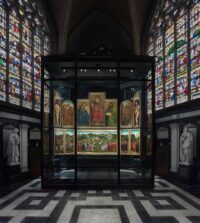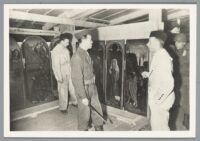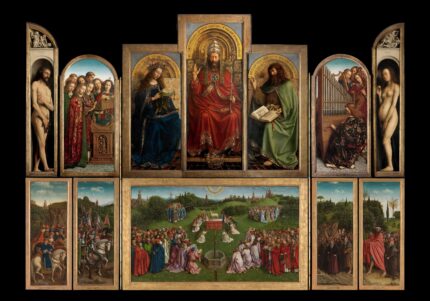 Almost a decade after a comprehensive multidisciplinary program of conservation and restoration began, the Adoration of the Mystic Lamb, also known as the Ghent Altarpiece, has gone back on display at Saint Bavo’s Cathedral in Ghent in a new high-tech setting.
Almost a decade after a comprehensive multidisciplinary program of conservation and restoration began, the Adoration of the Mystic Lamb, also known as the Ghent Altarpiece, has gone back on display at Saint Bavo’s Cathedral in Ghent in a new high-tech setting.
The double-sided 12-panel polyptych by Hubert and Jan van Eyck has been relocated from a small chapel near the entrance to the Sacrament chapel, one of the largest chapels in the cathedral and close to the location where the altarpiece was first installed. The space was enlarged to make way for a new bespoke display case and to aid in the flow of traffic when visitors can once again flock to see the Northern Renaissance’s greatest masterpiece.
The custom case cost more than $35 million. It is bulletproof, climate controlled and contains pneumatically controlled steel supports that allow the wings of the panels to be opened every morning and closed every evening so at different times visitors can see both the vividly colored front of the panels and the muted tones and grisailles on the reverse.
Experts from the Royal Institute for Cultural Heritage (KIK-IRPA, Brussels) discovered a great deal about the iconic masterpiece, removing centuries of discolored varnish, retouches and overpaint to reveal the original work by the van Eycks. From 2012 until its completion at the end of 2019, the program’s archival research, radiography, multispectral imaging and ground-breaking technical study cast new light on Van Eyck’s original vision for the polyptych. The Mystic Lamb, central figure of the composition, got a completely new face, or rather got his first, much more human-like face back.
 The research, documentation and imaging data were integrated into a truly best-in-class website with high-resolution photographs of the Ghent Altarpiece. The website has been active for years, sharing the results of this seminal study of the altarpiece in granular, brushstroke-level detail. Most recently, the complete oeuvre of Jan van Eyck, his studio and followers has been added to the site, so its purview goes far beyond the altarpiece alone.
The research, documentation and imaging data were integrated into a truly best-in-class website with high-resolution photographs of the Ghent Altarpiece. The website has been active for years, sharing the results of this seminal study of the altarpiece in granular, brushstroke-level detail. Most recently, the complete oeuvre of Jan van Eyck, his studio and followers has been added to the site, so its purview goes far beyond the altarpiece alone.
Visitors to Saint Bavo’s will first be directed to the crypt where art works and objects related to the altarpiece and the Van Eycks, including the grave of Hubert van Eyck, are exhibited. The experience is enhanced by Microsoft HoloLens, which unlike VR helmets allows users to see the space as it is while adding a digital layer of augmented reality. The headset tours will illuminate the history of the altarpiece, how it was created, the meaning of its dense allegories and portraits.
For now, pandemic measures restrict the number of visitors allowed into the crypt and the chapel — 350 tickets a day for the former, five people at a time for the latter.

Watch it like it’s 1521AD plus the lions :boogie:
——–
“…Early on Tuesday we departed, but before that, I did Jan Prevost’s portrait in silverpoint, and gave his wife 10 stivers at parting. And so we traveled to Ursel; there we breakfasted. On the way there are three villages. Then we traveled towards Ghent, again through three villages, and I paid 4 stivers for the journey, and 4 stivers for expenses; and on my arrival at Ghent, there came to me the dean of the painters and brought with him the first masters in painting; they showed me great honour, received me most courteously, and commended to me their good-will and service, and supped with me. On Wednesday early they took me to the tower of St. John’s[*], whence I looked all over the great and wonderfultown, where I had just been treated as a great person. Afterwards I saw the Jan [Van Eyck’s] picture, which is a very splendid, deeply studied painting, and especially the ‘Eve’, the ‘Mary’, and ‘God the Father’ were extremely good.
Then I saw the lions and drew one of them in silverpoint; also I saw on the bridge, where men are beheaded, two pictures which were made as a sign that there a son had beheaded his father. Ghent is beautiful and a wonderful town; four great waters flow through it. I gave 3 stivers as a tip to the sacristan and the lions’ keeper. I saw many other remarkable things in Ghent, and the painters with their dean did not forget me, but ate with me morning and evening, and paid for everything, and were very friendly. I gave away 3 stivers at the inn on leaving. Then early on Thursday I set out from Ghent and came through various villages to the inn called ‘The Swan’, where we breakfasted; thence we passed through a beautiful village and came to Antwerp, and I paid 8 stivers for the fare.”
——–
Source: Albrecht Dürer, Visit to Bruges and Ghent –April 6-11, 1521. [Myself, I visited Gent –and the piece– about roughly estimated 15 years ago].
(*)”The building is built on the site of the former Chapel of St. John the Baptist, primarily of wooden construction that was consecrated in 942AD by Transmarus, Bishop of Tournai and Noyon.”
:hattip:
—-
PS: Today (hopefully) about to kick off: procyclingstats.com/race/gent-wevelgem/2021/
It is an interesting thought, though, that restorers had to destroy one piece of art (the overpaint) to reveal the other (the Van Eijck parts). It all belongs to the history of the piece, yet we can only reveal one to the public. Choose one, and the other either remains hidden forever, or is destroyed in the process.
All things considered I think it is justified to remove the overpaint, but that too was the ancient work of a man, in itself.
$35 million for the case?!!!
Recently listened to the book about lost, stolen, found art treasures after WWII. “Museum Men”
This screen was mentioned numerous times in the book. Very interesting to see it now, and that it is enclosed in a case.
Thanks for the news. The Adoration of the Mystic Lamb at Saint Bavo in Ghent is worth seeing again and again. Looking forward to an opportunity to visit Ghent and see the restored masterpiece.